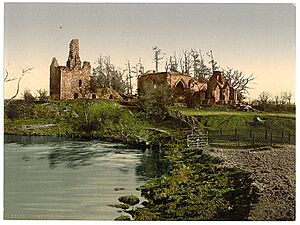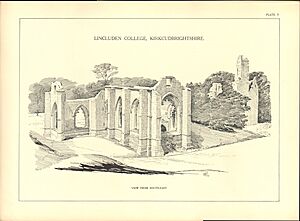Lincluden Collegiate Church facts for kids
Lua error in Module:Coordinates at line 614: attempt to index field 'wikibase' (a nil value).
Lincluden Collegiate Church, which used to be called Lincluden Priory or Lincluden Abbey, is a ruined religious building in Scotland. It is located just north of the town of Dumfries. The ruins stand on a bend of the River Cairn, right where it meets the River Nith.
This spot was first the site of a very old castle. The religious house was built around the year 1160. It served different purposes over the centuries until it was finally left empty around 1700. Today, the ruins are protected as a scheduled monument, which means it is an important historical site.
Contents
The Meaning of the Name
The name Lincluden comes from an ancient language called Brittonic. The second part of the name, "cluden," comes from the nearby Cluden Water river. The first part, "Lin," might come from the Brittonic word *lann, which means 'parish', or *linn, which means 'pool' or 'lake'.
History of Lincluden
A Home for Nuns
The priory was founded by a powerful ruler named Uchtred, who died in 1174. He ruled an area called Galloway with his brother. Unlike his father, Fergus, who built many religious houses for monks, Uchtred decided to build a place for nuns. This was the first nunnery in Galloway. The first nuns to live there likely came from France or England.
Uchtred's time as a ruler was difficult, with many conflicts. He was killed by his own brother in 1174, making Lincluden the only religious house he ever founded.
A New Church for Priests
In the late 1300s, the powerful Archibald the Grim, the 3rd Earl of Douglas, took control of the area. He decided to make a big change at Lincluden. He claimed the nuns were not following their religious rules. He removed the nuns and transformed the priory.
Earl Archibald ordered a new church to be built on the site. It became a College, which was a special church run by a head priest called a Provost and twelve other priests called Canons.
The Douglas family spent a lot of money making the church beautiful. You can still see many detailed carvings of family crests in the stone ruins. One of the most famous parts of the ruin is the tomb of Princess Margaret. She was the daughter of King Robert III of Scotland and the wife of the 4th Earl of Douglas.
Later Years and Abandonment
The church survived the Reformation in 1560, a time when many religious buildings were destroyed. The last official church service was held on Christmas Day in 1585. After the last provost left around 1590, the buildings were turned into a type of fortified house. By the late 1600s, this house was also abandoned, and Lincluden began to fall into ruin.
Protecting the Ruins
Over the years, the ruins suffered from neglect and damage. In 1772, a writer named Thomas Pennant visited and wrote that Princess Margaret's tomb had been badly damaged by people hoping to find treasure.
In 1882, the owner of the site, Captain Maxwell of Terregles, had the ruins cleaned up and protected by a fence. In 1922, the government took over the care of the site to preserve it for the future.
More recently, the ruins have faced vandalism. The stone figure on Princess Margaret's tomb was damaged. To protect it, the original statue was removed in 1999 to be cared for. A high-quality copy was put in its place so visitors can still see what it looked like.
A Place of Inspiration
The beautiful, quiet ruins of Lincluden have inspired famous writers.
The famous Scottish poet Robert Burns visited Lincluden. He was so moved by the sight of the "roofless tower" that he wrote a song about it in 1794.
The writer Robert Louis Stevenson, famous for books like Treasure Island, also visited the ruins with his father in 1873 during a walking tour.
Notable People Buried Here
Several important people from history are buried at Lincluden:
- Uchtred of Galloway (died 1174): The man who first founded the priory for nuns.
- Archibald the Grim (died 1400): The powerful earl who turned the priory into a collegiate church.
- Princess Margaret (died 1450): The daughter of a Scottish king and wife of an Earl of Douglas. Her tomb is a key feature of the ruins.
- Alexander Carnys: The second Provost of the church, who died in 1422. His gravestone is in the south part of the church.
- Alexander Couper: A stonemason who died in 1588.




